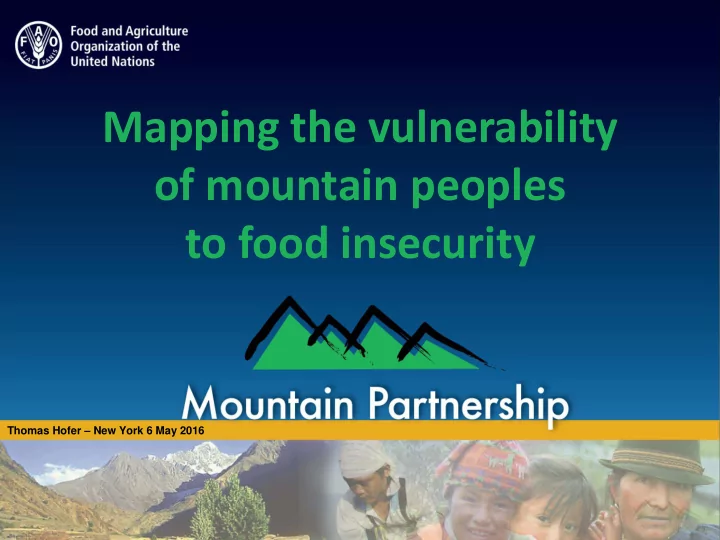

Mapping the vulnerability of mountain peoples to food insecurity Thomas Hofer – New York 6 May 2016
Why focus on mountains? 22% of the earth land surface 915 million people = 13% of global population 60 - 80% of global freshwater 25% of terrestrial biodiversity 60% of all Biosphere Reserves 15-20% of global tourism
Why this study? Measuring the vulnerability of mountain people (update) Understand trends (2000-2012) Inform policy makers and support advocacy campaigns Form basis for further research Promote investments in mountains
Mountain areas 32 million km 2 = 22% of earth’s land surface
Mountain population (2012) 915 million people live in mountain areas 13% of the world’s population, of which 70% live in rural areas
Mountain population (2012) Mountain population by region: 91% in developing countries (835 million) 9% 22% A Africa L Latin America and the Caribbean 17% 52% C A Asia D Developed countries
Mountain population trend Overall there was a 16% increase from 2000 to 2012 Mountain population trend by region 500 Mountain population (million) 2000 400 2012 300 200 100 - Africa Latin America Asia Oceania Developed Countries
Vulnerability to food insecurity 2000 : 253 million = 35% mountain population rural : 209 million = 38% 2012 : 329 million = 39% mountain population rural : 274 million = 45% Since 2000 the number of people vulnerable to food insecurity in the mountains has increased
Vulnerability by regions
Methodology Defines as vulnerable: Rural population living in areas with < 1370 kcal/person/day (beans, cassava, maize, potatoes, rice and wheat ) and < 14 gr proteins/person/day (meet: beef, sheep goat, pig, chicken; milk: cow, sheep, goat; eggs) Urban population living below the national poverty lines ( 23.6% according to WB for 2012)
Conclusion The number of food insecure people in the mountains is unacceptably high: Rural mountain areas: 1 in 2 Global average: 1 in 8 (SOFI 2012, FAO)
The way forward (I) 22% of the earth land surface 915 million people High vulnerability to food insecurity 60 - 80% of global freshwater Lack of political 25% of terrestrial biodiversity attention 60% of all Biosphere Reserves 15-20% of global tourism Paradigm shift is required!
The way forward (II) Nobody should be left behind! Joint effort of all countries to meet SDGs Collaboration of all mountain countries Targeted investments Mountain facility (launched on 22.4.)
Thank you for this opportunity!
Recommend
More recommend